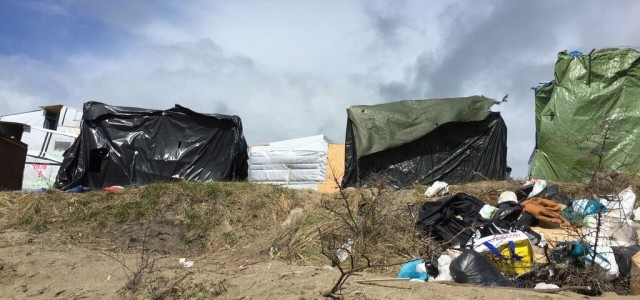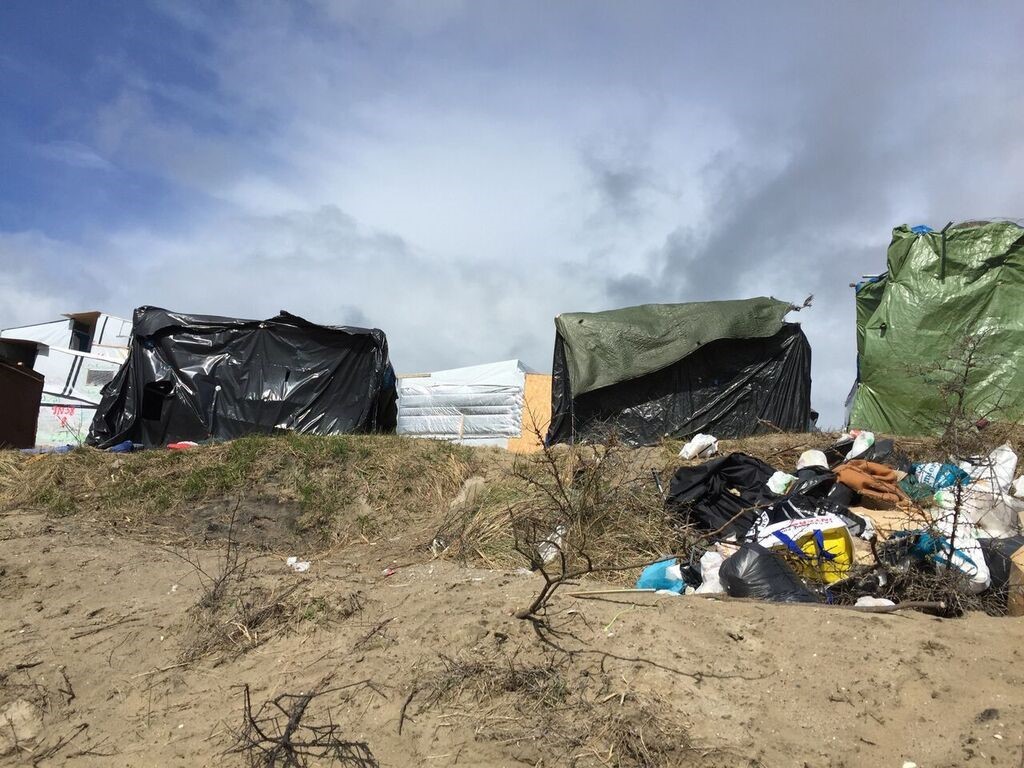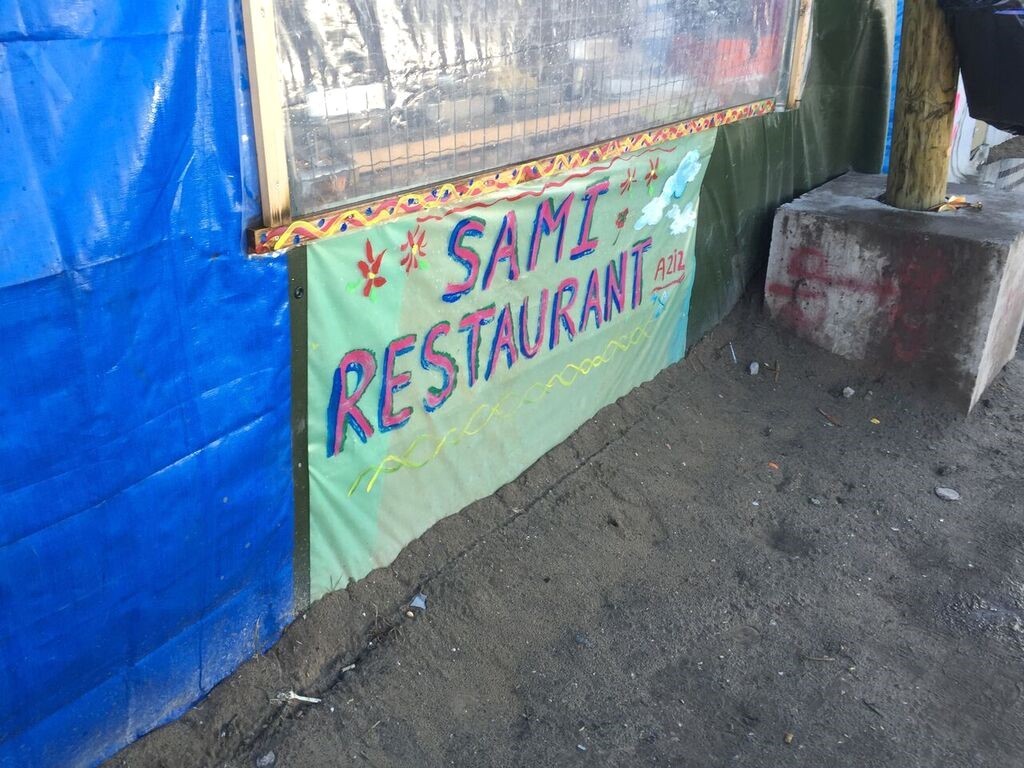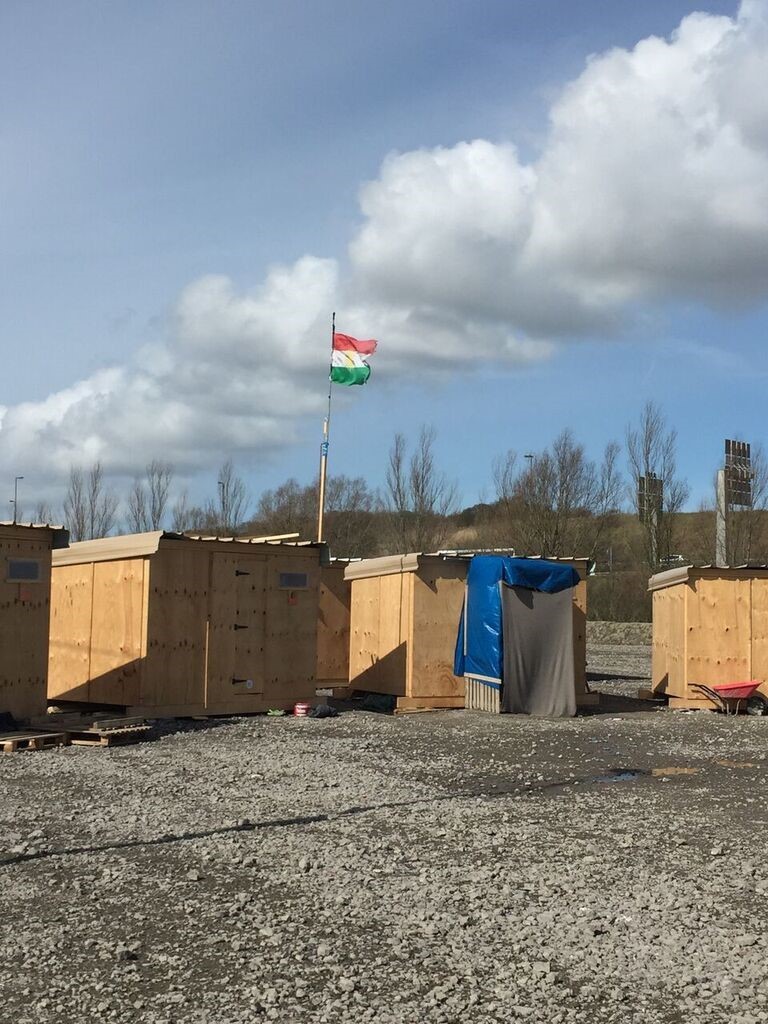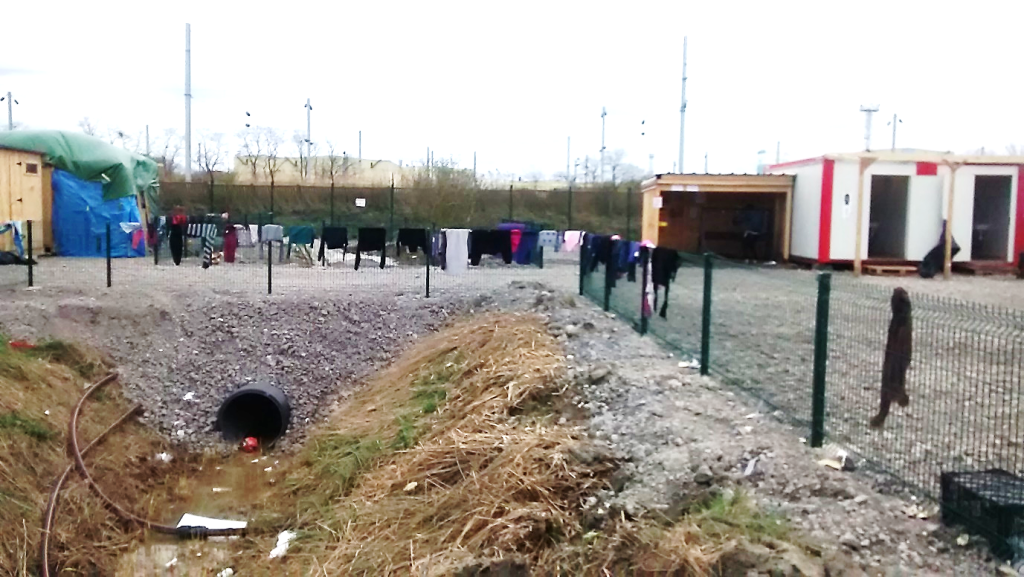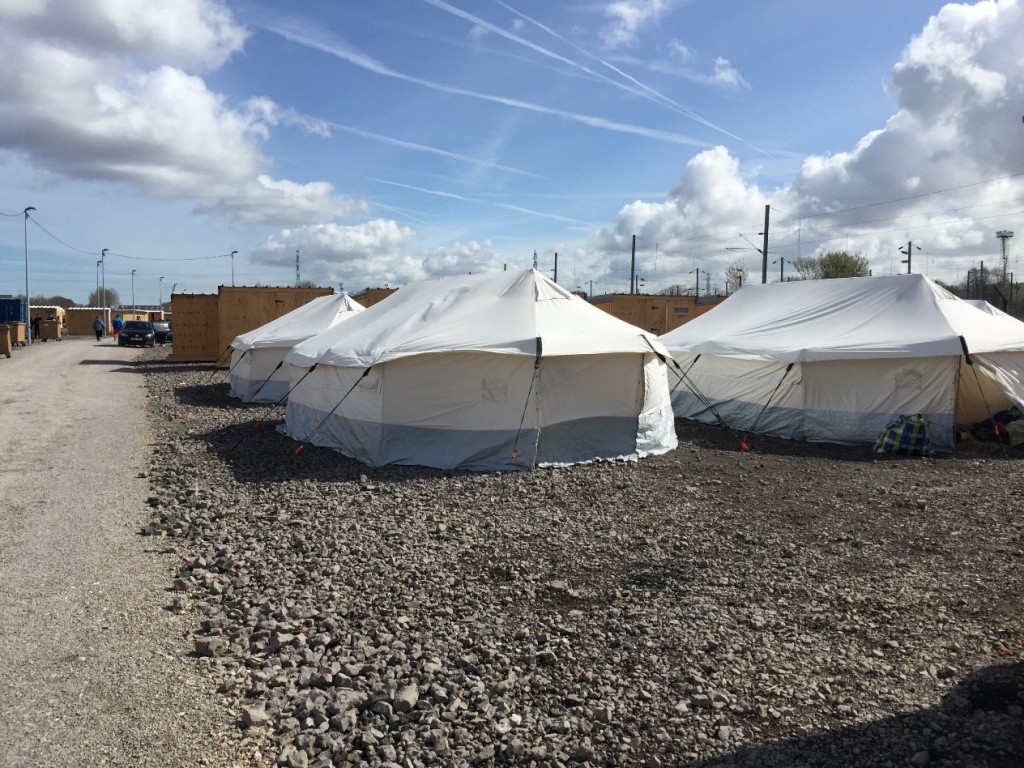Teresa Piacentini
France is getting better at building refugee camps. On its own soil. In 2016. This was a conclusion reached in conversation with Damien Carême the Mayor of Grande Synthe during a four-day visit with a delegation of SNP MPs, academics, practitioners and activists to Calais and Grande Synthe at the end of March 2016. The aims of our trip were multiple: to bear witness to the humanitarian crisis in France; to undertake a fact finding mission on what is happening on the ground; to speak with, listen to and hear the people in the camps, and the volunteers; to use this experience as a foundation for a call for action that would require alternative ways of seeing, hearing, listening and talking about the most significant European humanitarian crisis of the 21st century.
We wanted to tell about this place, and drawing on our varied backgrounds think about how this telling might mean different ways of conveying not just what we see and hear, but also what we see and feel and our moral and political commitments. Although we didn’t express it explicitly, at the core of our collective approach was the beginnings of doing live sociology; using all of our senses, observing on the move, digitally recording what we saw and doing so in a collaborative way, hearing, smelling, using voice and the bearing witness approach as political method to make muted realities more real and heard differently.
Before the trip we prepared as a group, mapping out our experiences of asylum, refugee and migration matters, our expectations, the aims and parameters of what would be ethical practice. Drawing down from ethnographic approaches, we understood the importance of immersing ourselves in the experience, even within the limitations of a short trip. We valued learning from ‘experts by experience’: the people in the camps and the volunteers working there. Working closely with colleagues from Medécins sans Frontières and Help Refugees UK, we spent time talking through the complexities of the camp structures in both sites and the administrative wrangling with local authorities. Together we visualised the camp space, mapping out where structures had been and where they remained. We listened to past and new challenges and pressures. This information gathering and extensive reflective and practical preparatory work was our ‘entrée’, to the field.
Calais
Although the southern part of the Calais camp has now been demolished, CRS presence looms large: riot police are assigned to the entrance of the camp, armed and on standby, tear gas canisters just visible in their belts. Once through we carefully pick our way across the rubble, trampling over the remnants of life in the south camp underfoot – scattered shoes, scraps of clothes, broken toys – to the low hum of bulldozers flattening the land, caterpillar tracks criss-crossing land that has been previously occupied by hundreds of people. This bleak landscape resembles a war zone: a battle ground for humanitarian protection, human rights, physical and emotional safety; political stability, and national security.
The remains of the Calais south camp. © Teresa Piacentini
Image: south camp, Calais ©Joe Brady
We move through this area to reach the northern part of the camp and the contrast is striking. The north camp has some semblance of ‘life’: through its centre runs a well-trodden gravel ‘road’ lined with cobbled-together shanty huts, makeshift shelters made out of planks, blue tarp, bin liners and tents.
Image: north camp, Calais ©Andrew Dickie
In this liminal space, we witness ‘community’ built from scratch, shop fronts sell cans of soft drinks, energy drinks, fruit and sim cards. Roadside stalls sell tens of cigarettes in silver paper. We smell cooking and baking bread. Such commercial activity challenges dominant perceptions of migrants/refugees as victims and/or villains. Instead it demands we see them as agents, and recognise the broader entrepreneurship in such spaces that is necessary for social survival and which remains a grey area because it contradicts the supposed transience underlying the camp concept.
Image: Shop front setting up for the day, north camp, Calais ©Teresa Piacentini
Image: north camp ‘restaurant’, Calais ©Andrew Dickie
A recently published report reveals the terrible and insanitary living conditions of this camp and life here is a daily struggle shrouded in banal everyday routines of getting up, brushing teeth, hanging about, waiting, sleeping. Boredom and hopelessness linger in the air and become embodied in the men waiting in line at distribution points for clothes, their heads hung low with shame; and in the emptiness of their eyes when they talk of living in the ‘jungle’.
We lift a tarpaulin to enter a restaurant, we smell fresh nan bread and are served sweet chai tea. On the walls draped in old sheets, notices for the ‘jungle radio station’ have been posted alongside multiple socket points for mobile phone chargers. People here work very hard at remaining technologically connected, participating remotely to life ‘back home’ and to life in the projected future, although this connectedness does not lessen any pain of separation or absence. In the restaurant, with the smell of fresh bread and taste of sweet tea we get drawn in and very quickly forget where we are. Stepping back outside, squinting in the spring sunshine, the shapes of camp life come back into focus and we remember.
Next to this camp, behind a metal fence structure lies the recently installed CAP container camp sleeping 12 people in each (Camp à l’Acceuil Provisoire = a temporary reception camp). There are many aspects that are striking about this container camp: it is a sterile place, like a ghost site: no music is allowed, no cooking facilities, no stalls selling cigarettes for 50 cents, no noise. It is silent, controlled and anonymous, uncontaminated by the messiness of life. These containers look imposing and cold. There are no graffiti messages of welcome that appear all over the north camp, no appeals to humanity, no calls for hope or action. There is none of the ‘survival’ that you see in the north camp, there are no ‘community structures’, it stands apart, with entry and exit controlled at turnstiles activated by handprints.
Image: CAP container camp, Calais, © Teresa Piacentini
Visualising these two camps side by side is unsettling: it forces us to ask questions about what this place is for? Is it a holding site? Is it to deter? Is it to protect? These two camps neatly juxtapose the dominant response to Calais: one of resignation to fear, of building fences and containers, of building borders within barriers and of denial of life.
Grande Synthe
But there is a second possibility: one of action that sees migration as an inevitability that can require an alternative approach that sees people in this situation as people. This reaction characterises what has happened in separate refugee camp in Grande Synthe, where the conditions had become so intolerable, with its rat-infested mud and swamp wasteland, absence of running water or any sanitation for the approximate 2500 people there. In the face of the failure of the French State, Grande Synthe’s Mayor, Damien Carême worked with MSF volunteers to peacefully relocate approximately 1500 people from the mud to the new site in three days. The camp is run by an experienced events management company Utopia 56. Described with pride by MSF and Maire Carême as an ‘open camp’ (with obligatory Gendarme presence at the main entrance), its residents, mainly Kurdish men, women and children, are free to come and go and there are no hand activated turnstiles. The camp is made up of heated wooden shelters, measuring six square meters, built to house four people. There is running water, toilets and showers so that it meets United Nations standards for refugee camps. Inside each shelter there are no chairs, beds or windows, nor any private cooking facilities.
Image: Grande Synthe wooden shelters ©Andrew Dickie
Image: Grande Synthe wooden shelters ©Andrew Dickie
This site is located between a motorway and a train line, far from the middle class suburbia of its former location. The irony of this location is not lost on its residents: planted between the rushing sound of trucks, cars and buses on side, and the low hum of trains passing on the other: non-stop mobility and movement a constant reminder of the geographical and political immobility its residents. Clearly integration is not the aim, the physical distance from amenities and everyday life keeps this site firmly out of sight. And although more ‘alive’ with recognisable sounds of people talking, children playing, and music from mobile phones, the social structures of camp life are missing. There is one long gravel ‘road’ that runs through the camp from one end to the other and men in the camp spend their time walking up and down this road, carrying fuel canisters to heat their cabins, or just for something to do.
Image: Grande Synthe, drying line ©Teresa Piacentini
Image: Grande Synthe communal tents and main road, ©Andrew Dickie
Over the course of our day there, we too walked this road, up and down and up and down. Sometimes on our own, nodding hellos to people we passed by, sometimes accompanied by men in the camp who fell into step by our side, sometimes in silence, other times talking: about why we were there, and why they were there. The monotony of this walk soon becomes tiresome. So, like its residents you try to resist, walking more slowly, stopping at new structures being built, wandering into communal areas where people congregate, continuing the journey, stopping to talk, or to drink a sweet chai and share salty sunflower seeds, talking and walking, walking and talking. In trying to know this place better, we understood that giving ourselves over to the patterns of camp life provided some kind of embodiment of this particular social world in motion; we saw, heard and for a fleeting moment could feel what this existence must be like, turning up the volume on this muted reality.
Yes, this camp is an improvement on the mud swamp and wasteland site. And for a moment, you really believe this, you look around and think, well this isn’t bad. But then you remember: ‘this’ is a purpose-built refugee camp. In France. In 2016. You recall Maire Carême’s eyes shining with hope when he told us he had no option but to act in the face of the failure of the nation to speak an ethical language of hospitality and responsibility. And then you remember the empty stares of the people in the camp and their everyday hopelessness. Fear of death doesn’t diminish because of the life one used to have. It is replaced with a fear of survival in this space: the boredom and monotony of the camp walk, the sense of losing one’s mind, the slow death. Out of the mud, but still stuck. As we leave the site a group of Kurdish men walk us out, an incredible act of hospitality in a cruelly inhospitable set of circumstances. We feel honoured and ashamed.
This camp is not the solution by any means, but it is one that accepts the inevitability of this type of migration. There is of course a bigger picture of the conflicting interests of the mayor who wanted it, the state that doesn’t, and the rock festival organisers who are supposed to run it. And beyond that, of the abdication of humanitarian responsibility on the part of the UK and the EU. Grande Synthe’s camp is hugely important: building a humanitarian camp implicitly acknowledges that France is in the midst of a humanitarian crisis. This in itself should force a humanitarian response beyond building wooden shelters.
So, France is gaining expertise at building refugee camps. On its own soil. In 2016. The question remains: what exactly are these places for? In the scramble for security and ‘keeping out’ perhaps they are to contain, to monitor, to protect, to deter and to forget.
Further reading:
Back, L. (2012) Live sociology: social research and its futures The Sociological Review 60(S1), 18–39.
Berger, J. and Mohr, J., (1975) A Seventh Man London: Penguin Books.
Teresa Piacentini is a sociologist at the University of Glasgow. She is an experienced researcher, interpreting practitioner and activist and has spent most of her professional and academic career working and researching mainly with asylum seekers, refugees and migrants in Scotland. Dr Piacentini accompanied Professor Alison Phipps of the Glasgow Refugee, Asylum and Migration Network (GRAMNet), the SNP’s Justice and Home Affairs Team at Westminster, Amal Azzudin and Pinar Aksu, human rights campaigners, Dr Anne Douglas OBE of the Compass Mental Health Team, Helen Baillot, a practitioner and researcher in forced migration, and Joe Brady the former Head of Integration at the Scottish Refugee Council as part of a four-day visit organised by refugee and human rights experts to bear witness to the conditions and issues affecting refugees during the current humanitarian crisis. Twitter: @teresapiacenti1
